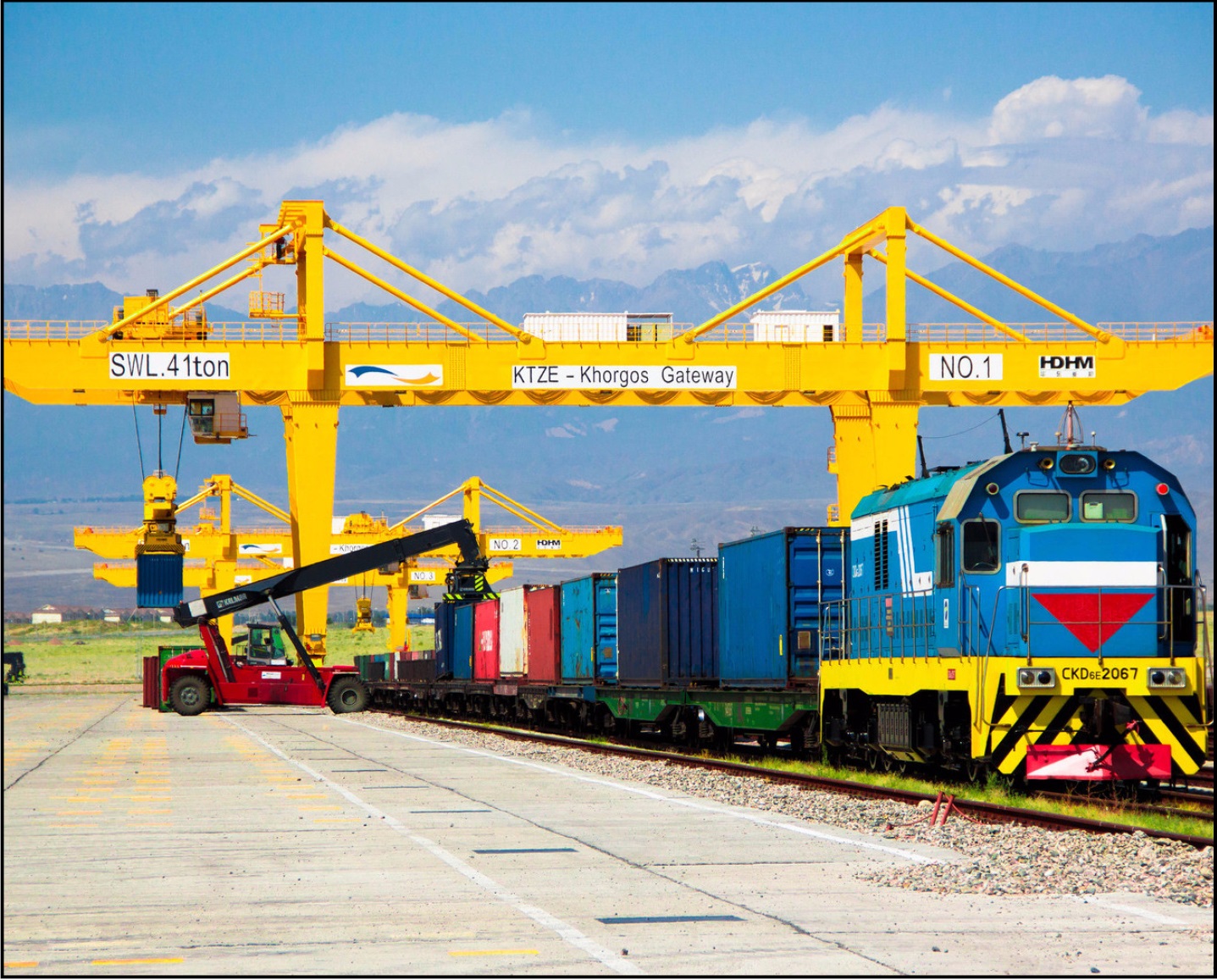Despite the ongoing global economic crisis being aggravated by the second wave of COVID-19 pandemic, this year has brought outstanding results for the KHORGOS “dry port” on the border between Kazakhstan and China, which links China with Central Asia, Russia and Europe. On October 6, 2020 when after less than five years of its opening, the 10.000th train crossed the border. Records this year are being broken in terms of freight volume. According to official statistics, 3,243 trains have carried over 4.7 million tonnes of freight across the border in Khorgos from January through September. This is a 32 % more than during the same period in 2019. This goes to prove BRI is not a concept anymore but a functional reality from the east of Asia to the west of Europe and the territories in between. CPEC will be an enormous force-multiplier north to south, connecting China and Central Asia to Middle East and North Africa through Pakistan.
Freight rail traffic is an alternative to faster but much more expensive air shipping, sea shipping is cheaper but takes much longer. It takes five to nine days to airlift cargo from a Chinese terminal to a European terminal. A one-way train trip takes from 15 to18 days, while to deliver cargo by sea takes from 37 to 50 days. Rail transport is good for high-value products, shipping by sea “freezes” these assets for a longer time, adding additional expenses for clients. In economic terms a two week period from production to market is more economic than around 45-50 days.

In terms of environmental considerations this is a favourable alternative because trains produce much less carbon emissions relative to trucks and aircraft. According to Fujitsu and Siemens, their “green trains,” which run between China and Germany, emit 95% less carbon monoxide, non-methane hydrocarbons and nitrogen oxides into the atmosphere than aircraft do. Because production plants in the north west provinces help reduce transportation compared with the coastal areas and bring jobs and development to the underdeveloped areas. For some time, China has been relocating manufacturing facilities northwest, to be nearer Europe. Similarly the Southwest (Sinkiang Province) is being developed on a fast-track basis. Twelve years ago, on October 6, 2008, the first demonstration container train ran from China to Hamburg. It was a 17-day trip from Xiangtan, Hunan Province. At the time, many people questioned the logic of this approach. But the advantages are clear today. Routes over 11,000 km long now directly link about 100 Chinese and European cities.
REAL TRAFFIC FROM CHINA TO EUROPE RECEIVED A STRONG IMPETUS IN 2011 WHEN THE CUSTOMS UNION OF RUSSIA, KAZAKHSTAN AND BELARUS WAS CREATED
The elimination of customs clearance procedures on the borders of these states drastically reduced documentation and logistics expenses and, thus, expedited freight transport services from China to Europe. According to China Railway, the number of China-Europe freight trains increased considerably in August 2020. An impressive record was set, with 1,247 trains per month or 62% more than in 2019, and August was the sixth straight month with double digit train volume growth year to year. In the first eight months of 2020, 7,601 freight trains, or 44% more than over the same period in 2019, were made via this route.
Westbound transcontinental trains leave for destinations in Europe almost every hour and eastbound trains to China depart every two hours. Rail shipping volumes in August 2020 jumped by 66 % over the same period in 2019, reaching 113,000 TEUs. Extrapolating, container volume will probably top one million TEUs this year. Today, of all freight volume on this route, about two-thirds move west and only one-third goes east. This situation is unlikely to change in the near future. A rapid increase in Chinese consumption volumes could become the most positive change in this respect. Increased consumerism would create additional demand for high-quality European goods.
To promote shipments to Europe, most landlocked Chinese provinces have subsidized domestic rail freight rates. However, many factors indicate that China is becoming aware of the fact that this situation cannot last long. A sustainable development of commercial ties with Europe need to depend on market mechanisms; the subsidies need to stop. Chinese media reports state that these subsides are being gradually reduced. Subsidies for European-bound railway traffic was as high as 50 % in 2018. However, subsidies were reduced to 40 % last year and are about 30 % this year. The authorities expect that all subsidies will end by 2022. According to logistics analysts, rail traffic volumes need to reach about 1.5 million TEUs to feasibly end government support.
Given this impressive increase in China-Europe freight rail traffic, it’s only natural to study its future prospects. It is important to understand the route’s bottlenecks and other factors that might hamper further traffic increase. Most logistics analysts agree that there are two main challenges in the mid-term. First, how to balance China-Europe and Europe-China cargo volumes. Second, how to boost the limited capacity of the Belarusian-Polish border crossing.
As for the Polish border, a map of China-Europe railway routes shows that virtually all trains are running through the Brest (Belarus)-Malaszewicze (Poland) checkpoint today, partly because Russia is avoid running these trains through Ukraine for political reasons. This situation will persist for the foreseeable future. It may seem strange, but the EU countries encounter serious problems with both cargo handling and the capacity of railway networks. It turns out that the European railway network is obsolete and has basic constraints that reduce its capacity. Logistics problems make Malaszewicze on the Belarusian-Polish border the main bottleneck on the entire China-Europe route. The border crossing is currently being upgraded which should boost the train handling capacity in this sector from 14 trains to 55 trains per day. Poland and the EU allocated 700 million euros for this project. The new Malaszewicze Transport Hub, with an area of 30 sq km, will be completely rebuilt. The project will modernise the hub’s railway infrastructure and thus drastically increase the speed of trains as well as the axle load on tracks.
Bureaucratic factors, including the standardisation of customs clearance procedures, the minimisation and simplification of administrative processes for freight clearance at the border and other details have to be improved to increase average train speeds, including border processes, which require international agreements. For instance, European railways stipulate pre-set maximum container train length requirements that limit freight volumes and increase operational expenses. An average Russian train has 71 standard wagons, and a Belarusian train from 57 to 65 wagons. However, EU regulations limit train length to 43 wagons. Consequently, trains entering Europe via Malaszewicze must have no more than 43 wagons with 86 TEUs. After a freight train arrives at the border with Poland, it has to be split: in Brest, containers are transloaded and used to make up a 43-wagon freight train. The rest of them remain at the border “waiting” for the next train.
Most analysts believe that container volumes will continue to increase in the near future. Experts from the Eurasian Development Bank estimate that, given the current infrastructure, maximum rail freight volume from China to Europe will amount to about two million TEUs annually. This shipping mode will then reach a practical capacity, where still lower rates will be needed to expand freight volumes further. It will also be necessary to invest in the physical infrastructure, the development of transport and logistics centres, more efficient locomotives and the automation of border-crossing procedures, as well as to digitalise documentation with block chain and smart contract technology, to standardise the regulatory legal framework and more effectively coordinate freight rates between partners.
Overall, there is every reason to believe that the Eurasian railway revolution will continue in the near future. The factors for developing the New Silk Road continue to fall into place. Beyond the above technical improvements, expanding the capacity of current routes and building new routes, including a new and shorter southern route from China to Europe via Kyrgyzstan, Uzbekistan, Turkmenistan, Iran and Turkey, will definitely add to these successes.

Pakistan must study this obvious success in rail traffic and balance its road traffic accordingly. Starting upgrading Peshawar-Karachi rail-link is not enough. We have to be visionary in thinking of other routes, viz (1) along the coastline to develop this vast Balochistan Province under developed area (2) to think in terms of a Gwadar-Kandahar rail corridor to connect with Central Asia and (3) to plan an alternate corridor on the west bank of the Indus, this will have national security connotations. The US only developed on a fast-track basis once railways traffic opened up the vast open area of the west after the American civil war. We need out-of-the-box solutions to take a studied but well defined definite leap into the modern age. We need a “Revolution in Rail Affairs” (RRA).




